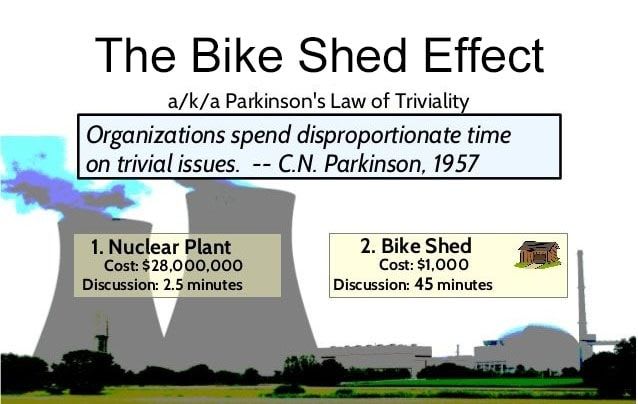Why do software teams spend hours debating the color of a button while glossing over critical security vulnerabilities? Why do corporate meetings devolve into lengthy discussions about coffee cup choices while ignoring major strategic decisions? The answer lies in two fascinating psychological phenomena: Parkinson’s Law of Triviality and bikeshedding.
These cognitive biases affect millions of professionals daily, from software developers arguing over variable naming conventions to executives fixating on presentation fonts. Understanding these principles—and learning to combat them—can dramatically improve productivity, decision-making quality, and team effectiveness.
In this comprehensive guide, we’ll explore the origins of these concepts, examine their real-world impact across industries, and provide actionable strategies to prioritize what truly matters. Whether you’re a developer, manager, or decision-maker, mastering these insights will transform how you approach complex problems and lead teams.
Parkinson’s Law of Triviality: A Historical Perspective
The Origins of a Timeless Insight
Parkinson’s Law of Triviality was first articulated by British naval historian C. Northcote Parkinson in his influential 1957 book “Parkinson’s Law: The Pursuit of Progress.” This principle, also known as the Bicycle Shed Paradox, reveals a counterintuitive truth about human psychology and organizational behavior.
The law states: “The time spent on any item of the agenda will be in inverse proportion to the sum of money involved.”
The Bicycle Shed Paradox Explained
In Parkinson’s famous thought experiment, a fictional finance committee reviews three budget items:
- £10 million nuclear reactor - Approved in 2.5 minutes with minimal discussion
- £350 bicycle shed - Debated for 45 minutes with passionate arguments about materials and design
- £21 annual coffee budget - Discussed for 75 minutes with detailed cost breakdowns
The paradox? The most expensive and complex decision received the least scrutiny, while trivial matters consumed disproportionate time and energy.
Why does this happen?
- Complexity barrier: Few people understand nuclear physics, so they defer to experts
- Accessibility bias: Everyone has opinions about bicycles and coffee
- Confidence correlation: People speak most confidently about topics they feel qualified to judge
- Status signaling: Contributing to discussions demonstrates engagement, regardless of value
Modern Relevance and Evolution
Since 1957, Parkinson’s insight has proven remarkably prescient. Research in behavioral economics and cognitive psychology has validated these observations, showing how cognitive biases affect decision-making across all human endeavors.
Bikeshedding: From Academic Theory to Tech Industry Terminology
The term “bikeshedding” gained popularity in the technology industry, particularly after Poul-Henning Kamp used it in FreeBSD development discussions in the late 1990s. It describes the tendency to focus obsessively on minor, easily understood details while avoiding complex, critical decisions.
Key characteristics of bikeshedding:
- Inverse complexity correlation: Time spent discussing issues inversely correlates with their importance
- Accessibility trumps significance: Everyone feels qualified to debate simple matters
- Analysis paralysis: Over-analyzing trivial decisions while under-analyzing crucial ones
- Ego involvement: People use minor decisions to demonstrate expertise or assert influence
The psychology behind bikeshedding:
According to research from Harvard Business School, bikeshedding occurs because:
- Cognitive ease: Simple problems feel more manageable and satisfying to solve
- Competence signaling: Contributing to discussions validates expertise
- Risk aversion: Complex decisions feel riskier and more overwhelming
- Social dynamics: Group settings amplify the tendency to focus on accessible topics
Bikeshedding in Software Development: Real-World Examples
The Development Meeting Paradox
Picture this scenario from a Fortune 500 technology company: A development team is architecting a new microservices platform handling millions of transactions daily. During their sprint planning meeting:
- 5 minutes: Approving a $50,000 cloud infrastructure budget
- 3 minutes: Deciding on database sharding strategy affecting scalability
- 45 minutes: Debating whether to use
getUserData()orretrieveUserInformation()as a method name - 30 minutes: Arguing about indentation (tabs vs. spaces) in the coding standards
Why does this happen? According to Stack Overflow’s 2024 Developer Survey, 73% of developers report spending more time discussing code style than architecture decisions because:
- Everyone understands naming conventions, but few grasp distributed systems complexity
- Code style feels “fixable” and within individual control
- Architecture decisions seem abstract and overwhelming
- Team members want to contribute something visible to the discussion
Case Study: The React Component Color Crisis
Company: Mid-sized fintech startup
Project: Customer dashboard redesign
Timeline: 6-week sprint
What happened:
- Week 1-2: Teams efficiently decided on React framework, state management, and API architecture
- Week 3-6: Consumed by debates over:
- Button color schemes (#3498db vs #2980b9 blue)
- Typography choices (Roboto vs Open Sans)
- Icon library selection (FontAwesome vs Material Icons)
- Loading spinner animations
The cost:
- 40+ hours of developer time in meetings
- Delayed feature delivery by 3 weeks
- Frustrated developers and stakeholders
- Opportunity cost of not addressing critical security vulnerabilities
The irony: The color changes had minimal user impact (A/B testing showed 0.2% difference in engagement), while the delayed security patches exposed the company to significant risk.
Common Software Development Bikeshedding Patterns
1. Code Review Bikeshedding
// 20-minute debate over this:
const data = response.data; // vs const responseData = response.data;
// While this passes without comment:
function processPayment(amount, cardToken) {
// Complex payment logic with potential security vulnerabilities
// that could affect thousands of transactions
}
2. Technology Stack Discussions
- 2 hours: Debating CSS framework (Bootstrap vs Tailwind)
- 15 minutes: Choosing database technology affecting scalability
3. Meeting Structure Bikeshedding
- 45 minutes: Discussing Slack channel naming conventions
- 10 minutes: Deciding deployment strategy for production
The Open Source Bikeshedding Effect
Linux kernel development provides classic examples. According to Linus Torvalds, mailing list discussions often follow this pattern:
- Core kernel architecture changes: Limited, technical discussion among experts
- Coding style guidelines: Hundreds of emails with passionate arguments
- User interface naming: Endless debates about terminology
This pattern led to the creation of automated code formatting tools like Prettier and Black to eliminate style bikeshedding entirely.
The Real-World Impact of Bikeshedding: Quantified Costs
Workplace Productivity Drain
Research from MIT Sloan School of Management reveals alarming statistics about bikeshedding’s organizational impact:
- 67% of meeting time is spent on low-priority issues
- $37 billion annually lost to ineffective meetings in the US alone
- Average 23 minutes wasted per day per employee on trivial decisions
- 43% of professionals report decision fatigue from over-analyzing minor choices
Personal Life: The Decision Paradox
The Restaurant Dilemma: A Stanford University study found people spend an average of 14 minutes choosing where to eat lunch but only 4 minutes reviewing their 401(k) investment options—decisions with vastly different long-term consequences.
Common personal bikeshedding examples:
- Spending hours researching $20 purchases while ignoring retirement planning
- Debating Netflix shows for 30 minutes instead of exercising
- Obsessing over social media posts while neglecting career development
- Over-researching trivial purchases while under-researching major life decisions
Corporate Meeting Epidemic
Fortune 500 case study: A major consulting firm analyzed 10,000 meetings across 50 companies, finding:
- Design discussions: 3x longer than budget approvals of equal financial impact
- Terminology debates: Average 18 minutes per meeting
- Process minutiae: 40% more time than strategic planning
- Email etiquette: More discussion time than cybersecurity protocols
The Psychological Toll
Bikeshedding creates cascading effects beyond lost time:
- Decision fatigue: Overanalyzing trivial choices depletes mental energy for important decisions
- Team frustration: High-performers become disengaged when forced into endless debates
- Innovation paralysis: Fear of bikeshedding can lead to avoiding necessary detailed discussions
- Impostor syndrome: People feel incompetent when unable to contribute to complex discussions
Evidence-Based Strategies to Combat Bikeshedding
1. The “Complexity Gate” Method
Implementation: Before any discussion, assess complexity on a 1-10 scale:
- Levels 1-3: Delegate to individual or use existing standards
- Levels 4-6: Time-boxed team discussion (15 minutes max)
- Levels 7-10: Full team analysis with expert consultation
Example framework:
Issue: Button color (Complexity: 2) → Designer decides
Issue: API architecture (Complexity: 9) → Full team + architect review
Issue: Variable naming (Complexity: 3) → Follow style guide
2. The “Decision Weight” Protocol
Assign dollar values or impact scores to decisions:
- Under $1,000 impact: Individual decision
- $1,000-$10,000: Team lead approval
- Over $10,000: Group discussion
Real example: A tech company reduced meeting time by 40% using this approach.
3. Automated Bikeshedding Prevention
Technology solutions:
- Code formatters: Prettier, Black eliminate style debates
- Decision trees: Automated routing for common choices
- Design systems: Pre-approved UI components prevent design debates
- Meeting bots: Tools like Krisp track topic time allocation
4. The “Two-Minute Rule”
Borrowed from David Allen’s Getting Things Done:
- If a decision takes less than 2 minutes to make, make it immediately
- Don’t schedule meetings for decisions that can be made by one person
- Use async communication (Slack, email) for simple choices
5. Role-Based Decision Authority (RACI Matrix)
Define clear decision ownership:
- Responsible: Who does the work
- Accountable: Who makes the final decision
- Consulted: Who provides input
- Informed: Who needs to know the outcome
Example RACI for development decisions: | Decision Type | Responsible | Accountable | Consulted | Informed | |—————|————-|————-|———–|———-| | Code style | Developer | Tech Lead | Team | Manager | | Architecture | Architect | CTO | Senior Devs | All | | UI colors | Designer | Product Manager | UX Team | Development |
6. The “Einstein Test”
Before lengthy debates, ask: “Would Einstein spend 30 minutes debating this?”
This cognitive reframe helps teams recognize when they’re bikeshedding by imagining how history’s greatest minds would allocate their attention.
7. Meeting Structure Reforms
Proven meeting formats:
- Lightning decision rounds: 5 minutes per topic maximum
- Async pre-work: Share opinions before meetings
- Decision logs: Record rationale to prevent re-litigation
- Devil’s advocate rotation: Assign someone to challenge groupthink
8. The “Opportunity Cost” Framework
For every hour spent debating trivial matters, calculate what else could be accomplished:
- 1 hour of button color debate = 2 bug fixes
- 30 minutes of naming discussion = 1 code review completed
- 45 minutes of font selection = Security vulnerability assessment
9. Cognitive Bias Training
Educate teams about common biases:
- Availability heuristic: Recent examples feel more important
- Anchoring bias: First suggestions heavily influence decisions
- Confirmation bias: Seeking information that supports existing opinions
- Social proof: Following group consensus without independent analysis
10. Success Metrics and Accountability
Track bikeshedding reduction:
- Meeting efficiency scores: Percentage of time on high-impact topics
- Decision velocity: Time from problem identification to resolution
- Debate-to-implementation ratio: Discussion time vs. execution time
- Team satisfaction surveys: Regular pulse checks on meeting effectiveness
Advanced Anti-Bikeshedding Techniques
The “Pre-Mortem” Method
Before starting projects, identify potential bikeshedding topics and create decision frameworks:
Project pre-mortem checklist:
- Design standards document created
- Technology stack decisions finalized
- Naming conventions established
- Decision authority matrix published
- Time limits for various discussion types defined
Cultural Change Implementation
Phase 1: Awareness (Weeks 1-2)
- Team education on bikeshedding concepts
- Historical analysis of past projects
- Identification of team-specific patterns
Phase 2: Framework adoption (Weeks 3-6)
- Implement decision protocols
- Practice new meeting formats
- Track initial metrics
Phase 3: Optimization (Weeks 7-12)
- Refine approaches based on data
- Address resistance and edge cases
- Establish long-term habits
Technology Industry Best Practices
Companies successfully combating bikeshedding:
Google: Uses data-driven A/B testing to resolve design debates
- 41 shades of blue tested for optimal click-through rates
- Removes opinion-based arguments with empirical evidence
Netflix: Implements “keeper test” for meeting efficiency
- Regular assessment: “Would we fight to keep this discussion?”
- Eliminates discussions that don’t meet the bar
Amazon: Two-pizza rule prevents bikeshedding through small team decisions
- Teams small enough to be fed by two pizzas
- Reduces coordination overhead and trivial debates
Spotify: Autonomous squad model with clear decision boundaries
- Each squad owns specific decision types
- Minimizes cross-team bikeshedding
Conclusion: Building Anti-Bikeshedding Organizations
Parkinson’s Law of Triviality and bikeshedding represent fundamental human tendencies that cost organizations billions annually in lost productivity. However, recognition of these patterns provides the foundation for systematic improvement.
Key Takeaways for Leaders
- Bikeshedding is predictable: It follows patterns you can identify and prevent
- Technology solutions exist: Automated tools can eliminate many trivial debates
- Cultural change is possible: Organizations successfully implement anti-bikeshedding practices
- Measurement drives improvement: Track metrics to ensure sustainable change
- Decision frameworks scale: Small process changes yield disproportionate productivity gains
Immediate Action Steps
For Individuals:
- Use the “Two-Minute Rule” for personal decisions
- Apply the “Einstein Test” before engaging in lengthy debates
- Practice saying “This seems like a good candidate for bikeshedding—should we time-box it?”
For Teams:
- Implement the “Complexity Gate” method in your next sprint planning
- Create a RACI matrix for common decision types
- Start tracking meeting time allocation
For Organizations:
- Invest in automated code formatting and design systems
- Train managers on cognitive bias recognition
- Establish clear escalation paths for different decision types
The Future of Decision-Making
As artificial intelligence and automation handle more routine decisions, human cognitive resources become increasingly valuable. Organizations that master anti-bikeshedding practices will have significant competitive advantages in innovation, speed, and employee satisfaction.
The goal isn’t to eliminate all detailed discussions—it’s to ensure that the complexity and importance of issues match the time and energy invested in resolving them. When teams focus their collective intelligence on problems that truly matter, remarkable things become possible.
Remember: Every minute spent debating trivial matters is a minute not spent solving problems that could change your industry, improve user lives, or advance your career. Choose where to focus your finite attention with intention and wisdom.









